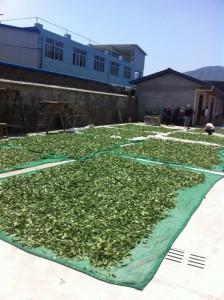Picking or plucking tea leaves are considered the lowest end of the chain. It has also been described as a mindless, banal activity that should be best replaced by machines. Perhaps that is the case for commercial grade tea leaves but for quality tea productions in China and India, top grades continue to be picked by hand.
Besides the selectiveness of hand picking, there is logic behind the time the leaves are picked. Not just the harvest season but the specific time and weather of the day.
The Weather
For most types of teas, leaves are not picked during rainy and cloudy days. This is due to the lack of sunlight and heat means that the dew remains on the leaves, leaving the taste of tea produced from it rather grassy and less aromatic.
Secondly, withering under direct or indirect sunlight is an essential step in the production of certain types of tea. Without the heat, moisture loss is reduced and the body of the taste of tea would suffer.
The Time of Day
An interesting note is that different types of teas have different recommended picking times.
Green Tea
For Taiping Houkui, tea leaves are picked between 6am to 10am, when the fields are still misty and fogging. At approximately 10am, the sun comes out, pickings ceased immediately.
The reason for doing so is that sunlight will cause a reaction in the amino acid reducing its accumulation. By picking the tea before the sunlight, the amino acid content is maximized and the umami taste and the refreshing qualities are better preserved.
For other types of wok-roasted leaves such as Longjing and Bi Luo Chun, the common practice is to pick it between 9 am to 12 pm to allow for part of the dew to evaporate but not much sunlight that it loses its refreshing quality.
Oolong Tea

Commonly the best time of the day for picking tea leaves is ranked in this manner from best to worst:
i) 2-4pm
ii) 4-5 pm
iii) 12-2 pm
iv) 8-10 am (typically not picked)
There are a few things that need to be considered.
First is the morning dew. The morning dew is a pretty sight, especially for macro photography, not so for production of tea. The evaporation of the dew results in more aromas and a more full bodied flavor
Second is the sunlight after picking the leaves. In the production of oolong tea, the next stage is withering, commonly under direct sunlight.
Ideally, tea leaves are picked between 2-4pm as the sunlight would not be at its brightest and the leaves would not be damaged from overheating. By the same token, leaves picked from 10 am to 1pm would be placed under the direct noon light and leaves picked after 4pm would not get sufficient sunlight.
Of course this is a general guideline as there is a balance between the refreshing quality and the fragrance and flavor of the leaves.
Hence Taiwanese oolongs made in the lightly oxidized styles might be picked a little earlier and withered indoors in order to preserve the amino acid content. This would give it a lighter, more refreshing taste as opposed to the fuller flavor of a traditional dancong or Wuyi Yancha.
Pu-er Tea
Pu-er teas typically are picked between 10am to 12pm with the morning sun just emerging and allowing ample time for the leaves to be withered under the sun. The withering will lower moisture content hence preventing over-oxidation and the leaves from turning moldy.
Black Tea
Black tea picking requirements are very similar to that of Bi Luo Chun above from 9 am to 12pm in order to allow the dew to evaporate. At the same time, as black tea are withered pickings should ideally be completed with sufficient daylight and heat for the natural withering.
Source:
i) Taiping Houkui (edited by Xiang Jin Ru, Zheng Jian Xin, Li Xu Ping and Published by Shanghai Wenhua Chubanse)
ii) Fenghuang Dancong (by HuangRui Guang, Huang Bo Xin, Gui Pu Fang, Wu Wei Xin and Published by Zhongguo Nongye Chubanse)
iii) Zuixin Tieguanyin Baiwenbaida (edited by Yu Xiao and Published by Hunan Meishu Chubanse)
